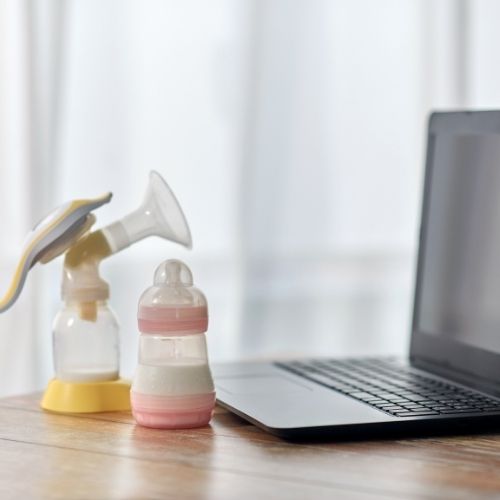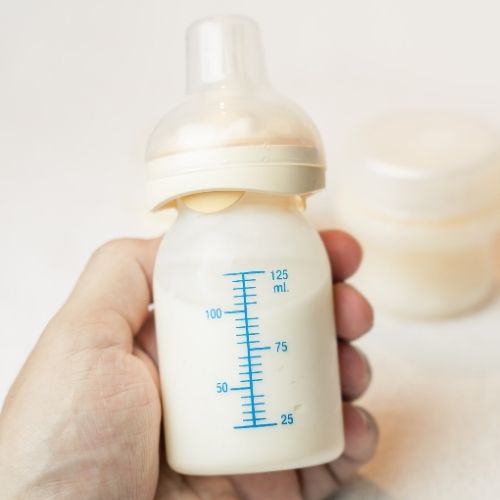Not knowing if your milk will come in the first few days after birth is a big source of stress for new moms. Here are some ways you can make sure you’re making enough milk for your baby and establishing a good breast milk supply from day one.
Although breastfeeding is the most natural way to feed your baby, it sure is complicated. There are so many things that can affect breast milk production and helping your milk come in.
As a labor and delivery nurse, a big part of my job is helping new mothers feed their baby for the first time. That first feeding can be tough! But I can assure you it does get easier.
Whether you are pregnant or just a concerned new parent with low milk supply, this post is sure to help. The good news is there is a lot you can do to help your milk come in or improve breast milk supply!

This article is not meant to replace medical advice. Please consult your medical provider with any health-related questions or concerns, read my full medical disclosure here. This post contains affiliate links. If a purchase is made using links on this website, I may earn a small commission at no additional cost to you.
How to know baby is getting enough milk
It can be especially hard the first few days after birth to make sure your baby is eating enough. Before your milk comes in, you won’t feel a “full” and then “empty” feeling after a feed. Many moms do not experience the let-down reflex until after their milk comes in.
In the first few days after birth, the baby’s stomach is about the size of a cherry pit. It only takes small amounts of colostrum to fill them up. Since they have such a small stomach, they will need frequent feedings in the early weeks.

Before your milk comes in, your body makes colostrum. Colostrum is a very sticky, thick, sweet milk that is loaded with calories and nutrients for your baby. Colostrum is one of the first ways we boost baby’s immune system.
When you express milk, you may notice it has a yellow hue whereas milk is typically white or a bluish color. The yellow color and it’s health benefits to baby are the reason for its nickname – liquid gold!
Your baby nurses will assess if the baby has enough milk. There are many different assessments that can be done to let you know if the baby is nursing well.
Ways to know baby is getting enough breast milk
Your baby’s healthcare provider will assess the following:
- baby’s weight gain. A baby that is gaining weight is getting enough milk. It can be normal for babies to lose up to 10% of their birth weight in the first few days after birth, but then they should start gaining the weight back. Your pediatrician will check in often to make sure baby is gaining enough weight
- the amount of wet diapers and dirty diapers. Baby’s nutritional needs are being met if they are making plenty of wet and dirty diapers.
- the baby’s behavior. A baby that is grunting and fussy is not getting enough milk. In the early days, babies should be relaxed and sleepy after a feed. If a baby is fussy or screaming, they may still be hungry
The best way to know if a baby is getting enough milk is to watch your baby’s cues. A baby that is relaxed with open fists and is sleepy after a feeding is likely getting enough milk.

7 Ways To Help Breast Milk Come In & Establish A Good Milk Supply
Low supply is common with many moms, but luckily there are a few things you can do to help your milk come in. It is normal for a mother’s milk to take up to 5 days to come in! These tips may help your milk come in sooner.
1. Breastfeeding Shortly After Birth
Ideally, baby should be fed within the first hour of birth. I encourage you to rely on your medical team for help with this first feed as it can be difficult to get a good latch when the baby is so fresh!
Breastfeeding within the first hour helps with bonding, establishing a strong milk supply, and encouraging your body to make more milk.
How often does a breastfed baby need to eat?
After that first feeding, you can breastfeed on demand. Typically that means every 2-4 hours following baby’s cues.
You should breastfeed when baby is alert and calm. A baby will breastfeed best when they are awake and active. You may notice your baby keeps turning their head with their mouth open wide – this is called rooting and it means your baby is hungry.
Crying is a late sign of hunger – try to feed your baby before they get fussy!
Wearing nursing-accessible clothing can make you more comfortable while also making it easy to feed baby after birth.
Related: Breastfeeding 101 For The First Time Mom

2. Skin-To-Skin Contact
If both mom and baby are well after delivery, immediate skin to skin contact is the best thing you can do.
Skin to skin contact helps baby adjust to life outside the womb. Babies that are able to do immediate skin to skin have less problems with breathing, blood sugars, and breastfeeding. Laying skin to skin with mom is best, but it can also be a great way for the other parent to bond with baby, too. The important thing is that the baby goes skin to skin with a parent!
Skin to skin is also a great thing to do the first week to help milk supply. It may help mom release both oxytocin and prolactin to promote breast milk production (source).
3. Use a breast pump
Pumping may not be necessary, but it can be a way to stimulate your body to make more milk.
The amount of milk you make is supply and demand. Using either a hand pump or an electric breast pump after a feeding will send signals to your body to boost breast milk production.

Adding a pumping session or two to your daily routine the first few days after birth can help your milk come in. During your postpartum stay at the hospital, you can ask your nurse or lactation consultant if they have a breast pump you can borrow. Most hospitals have them available for new parents.
At home, an electric pump can also help you if you are making more milk than the baby can eat. If you are planning to return to work, or know that there will be times baby needs a bottle, then building a freezer supply of milk is a good idea. I used the Spectra pump with all three of my kids and I found I made much more milk than with Medela (it’s absolutely a breastfeeding must-have!)
Related: 10 Pumping Mistakes That May Hurt Your Milk Supply
4. Breast Massage
Gently massaging your breasts while either breastfeeding or pumping can increase your milk supply. It can help release milk from the milk ducts and increase milk flow.
Hand expression with breast massage can also help with engorgement. If your breasts are too full, your baby may not be able to establish a good latch. Hand expressing milk before a feeding may help soften the breast enough for baby to be able to eat.
5. Indulging In “Milk Booster” Foods
There are many foods and drinks that claim to boost milk supply. These are called galactagogues, and you may be surprised to see which foods can help increase breastmilk supply.
Adding some of these foods to a well balanced diet may be an easy way to make more milk. There is not great research to support this, but a lot of moms claim their milk supply increases after eating some of these foods!

Here are some common milk boosting foods:
- oatmeal
- brewer’s yeast
- fennel
- fenugreek
- flax seed
- chia seeds
Lactation cookies are a common way that moms pack a bunch of galactagogues into one tasty treat. Since breastfeeding moms need to boost their water intake and eat between 450-500 extra calories per day, you can try indulging in some of these to meet that need.
Lactation teas also claim to help moms make extra milk. A cup or two per day may help you make enough breast milk.
Drinking sports drinks, like Body Armor or Gatorade, can help make sure you are hydrated enough to make enough milk.
You don’t have to go crazy with these. Eating a balanced diet full of whole grains, fruits and vegetables and drinking a lot of water can help you make plenty of milk.
For a full list of milk boosters, click here.

6. Ask for help from a healthcare provider
If you are very concerned about your ability to make enough breastmilk, you may want to contact your healthcare provider.
There are some medical conditions that can affect your ability to make milk. Disorders of the pituitary gland and diseases that affect breast tissue can make it hard for your body to make enough milk.
A lactation specialist can also check to make sure your baby is latching properly. If breastfeeding is painful or uncomfortable, try some of these techniques or call a lactation consultant. Lactation consultants can meet with you virtually or in person to watch your baby feed and make sure that everything looks good.
You can ask if your hospital is staffed with an international board certified lactation consultant (IBCLC) to help you during your hospital stay. Many insurance companies will also cover home visits of lactation specialists.

Related: 8 Breastfeeding Tips For The First Time Mom
7. Be patient and persistent (keep trying!)
There is no shame in bottle feeding, but if breastfeeding is your ultimate goal then I encourage you to keep trying!
Typically, breastfeeding is toughest with the first baby. After you have mastered breastfeeding, you’ll know what to do for your second baby.

From personal experience, I have found that the first month of breastfeeding is the hardest. Breastmilk supply tends to be regulated and established by 6 weeks, and after that things are usually much easier. It may seem like a long time, but it can take that long for some moms to establish a good milk supply.
If you’ve decided breastfeeding isn’t for you, learn how to quickly and safely dry up breast milk here.
Related: How Long Does Reheated Breast Milk Last? A Guide For Milk Storage
Lack of sleep, stress, not drinking enough water, or traumatic labor and delivery can affect your milk coming in. Be sure to take in extra fluids, eat a healthy diet, relax and enjoy your baby!
Know any other ways to help milk come in or boost milk supply? Let me know in the comments – you may help another mom out!


